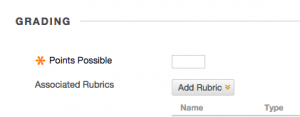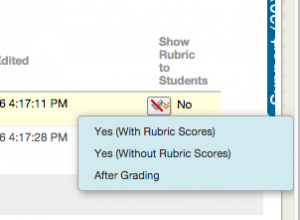Challenge (Joe Martel-Foley): How to use Rubrics and comment on student work
Can you explain the process for how to use a rubric I created for grading lab reports? Can I use this is a later class?
Is there any way to comment within the files turned in through blackboard to give specific comments on sections of text?
Using a Rubric for Grading
Once you’ve created a rubric, you need to attach it to the appropriate assignment. When setting up an assignment there is an option to associate a rubric in the grading section of the assignment set-up page:
Click on the Add Rubric button and select the rubric you created. Select Grade By for the type of rubric.
Select any additional grading options and submit the assignment.
When you grade the assignment you will go to the Grade Center and grade using the inline grading tool. Instead of entering a single score for the assignment you can select rubric cells and add feedback to the student. After you’ve selected the levels of achievement for each criterion, save the rubric to update the grade in the grade center. See Blackboard’s full instructions on grading with rubrics.
To make sure students can see the rubric and any associated feedback, select one of the “show to students” options when associating the rubric:
Using a Rubric in Another Course
To use a rubric created for one course in another you can export the rubric and then import it into another course. Alternatively, if you copy a course with a rubric into a new shell, you can select the rubrics as an option to copy. Exporting rubrics is the best way to share rubrics with colleagues.
Commenting on Student Submissions
Using the inline grading tool you can comment on student work. Students must submit in one of the accepted formats, however. These formats include MS Word, pdf, txt, MS PowerPoint, and MS Excel. (Note: PowerPoint and Excel do not have interactivity. To assess interactivity in a PowerPoint or see formulas in Excel files you will need to download and open the files.)
When you open an assignment using the inline grading tool – either from the Grade Center Column or from the Needs Grading page – you can add text comments, highlight, or draw on the submission. Click on the Comment button to display the Commenting tool bar.





